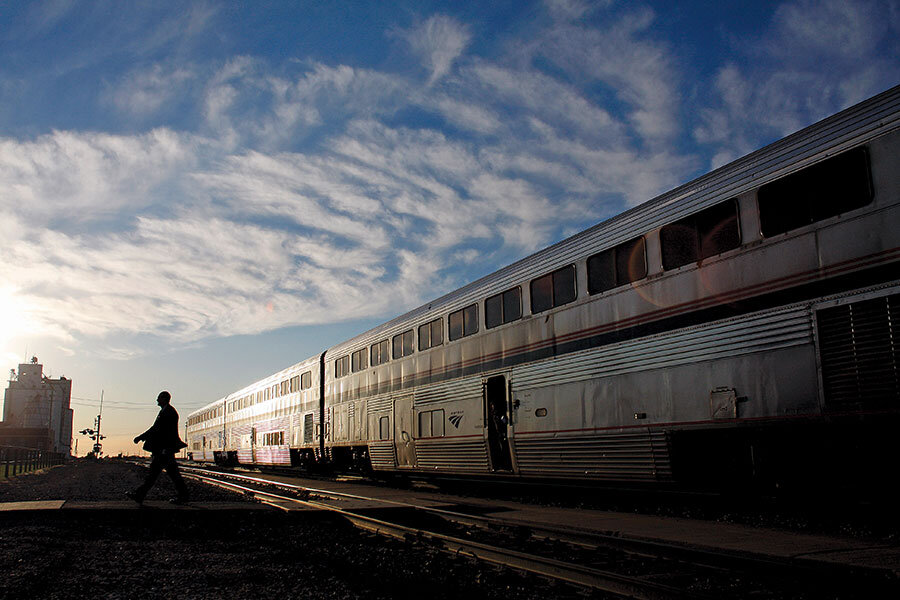Why I’m still drawn by trains
Loading...
On a recent visit with friends at their home in Grand Rapids, Mich., I asked Ann and David if I could switch off the air conditioning in the guest room and open the windows. I’ve never slept well sealed off from the ambient outside air (however humid) and night sounds. That was fine with my accommodating hosts. I also knew Grand Rapids to have an Amtrak passenger link to Chicago and a lively traffic in freight. With windows up I could attend the trains coming and going as I fell asleep and woke again. I didn’t want to miss that.
My hometown of the past 40 years, Bloomington, Ind., saw its last regular passenger train depart for Chicago in 1979. A freight or two may glide past the old station-turned-upscale restaurant now and then, but Bloomington no longer offers the rhythms of the rails as an accompaniment to daily life or nightly slumbers as does Grand Rapids, my childhood home of Rochester, N.Y. (where I can still lie abed on visits home to restfully attend those whistles), or Galesburg, Ill. – one of my favorite cities with an Amtrak station.
There is something about these cities that Bloomington now lacks. It’s not just the trains’ sweet punctuation of the day but the personal connection they offer when travel beckons. A small station parking lot and short walk to a platform begins a journey without long lines, elaborate security procedures, or baggage checks.
Galesburg, on Amtrak’s Southwest Chief route as it crosses the Plains from Chicago to Los Angeles, typifies this experience. First with my son, and now my grandson, I have long chosen to drive from Bloomington over the state line to catch the train in Galesburg to visit friends in Colorado (the train stops in Trinidad, where we are picked up by the family in their Subaru for the final leg to their home below the Spanish Peaks). For a host of logistical reasons (this being a country without abundant and timely rail connections in the Midwest), departing from Galesburg is the easiest way to travel west for me.
We leave early, and spend the afternoon enjoying the little town’s shops, restaurants, and (yes!) train museum adjoining the station. Between 5 and 6 p.m. the light and horn of the Southwest Chief beckon from around a bend in the tracks, inevitably raising goosebumps on small arms. We board, we glide across the Mississippi, we dine, sleep, and waken in the West. Sometimes in the night I awake briefly in Missouri or Kansas, where huge grain silos rise into quiet black skies.
Trinidad has no station structure, just an open platform where we alight and transfer our luggage to the Subaru, which also returns us at the end of our stay.
Once, on our return trip, I encouraged our hosts to simply drop us off for the expected short wait in the balmy air. Grandson Connor explored along the tracks and found an old iron spike long since tossed aside in an upgrade to the rails. The train, as it happened, was well over an hour late and the weather began to turn. Storm clouds gathered, muffled thunder roared, and lightning began to dance. I eyed a distant highway overpass as potential shelter – but we might miss the train, which only stops for a minute there. As I mulled over our dilemma, the welcome lights of the Chief materialized and we heard the horn in the distance. As it neared, a conductor folded out the boarding steps and reached to us, one hand clutching the rail.
“Sue and Connor?” he called out.
“How does he know our names?” Connor gasped as we sprinted for our braking shelter. I was also impressed that our reservation on an economy sleeper included this personalized service. The train ground to a stop and we clambered up, treasured rail spike and all, just as the skies opened in a serious deluge. It has remained a vividly memorable Amtrak moment, though it might easily have been a disaster, what with today’s sometimes-chaotic schedules and open-air waiting platforms.
But the magic of boarding a train for an overnight journey remains alive and well for me and mine, and we cling to what we still have. Recently we caught the Southwest Chief in Galesburg once again, hoping for the best. It pulled in only 40 minutes late. The skies opened somewhere on the Plains and lightning flooded our little rocking compartment more brightly than daylight – one more memorable experience on the rails.
On the return journey we waited on Trinidad’s bare concrete platform for three hours (the Chief was having difficulty climbing Raton Pass to the west, we learned from a fellow traveler with an app). The evening was clear and balmy, and we passed the time striking up ephemeral friendships – until that light appeared around the bend at last, and the goosebumps appeared.
We’ll keep traveling by rail. And whenever we spend time in towns with regular train traffic, we’ll be sure to open our windows at night.







